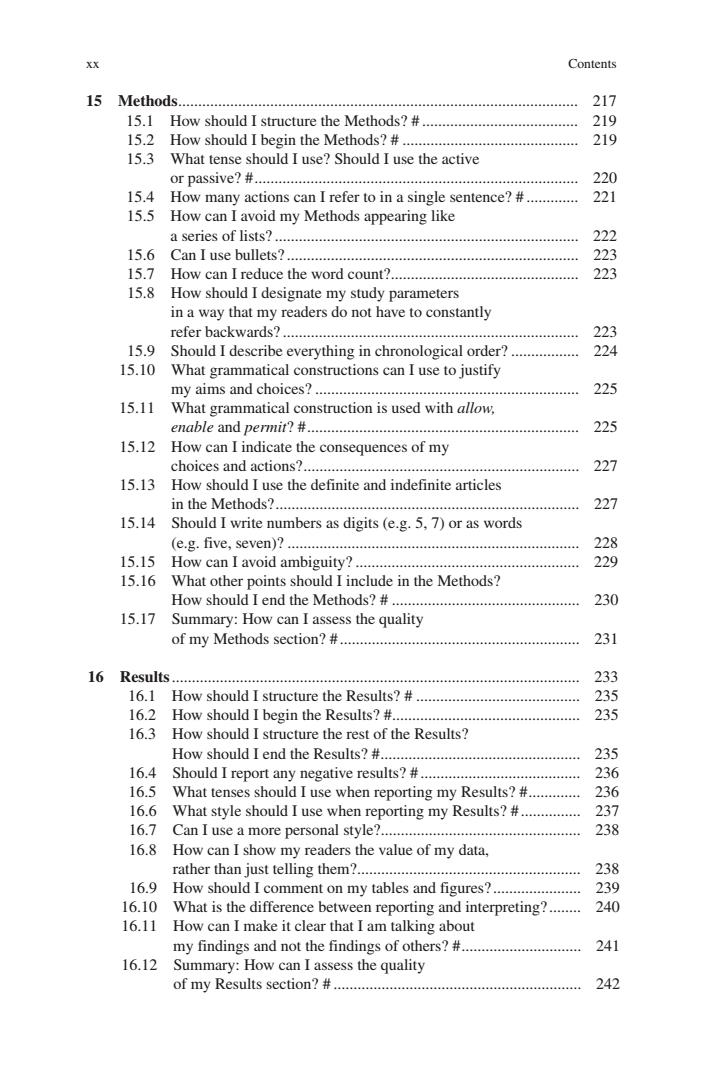
XX Contents 15 Methods....... 217 15.1 How should I structure the Methods?#...................... 219 15.2 How should I begin the Methods?#...................... 219 15.3 What tense should I use?Should I use the active OI passive? 220 15.4 How many actions can I refer to in a single sentence? 4444444 221 15.5 How can I avoid my Methods appearing like a series of lists2.… 222 15.6 Can Iuse bullets?. 223 15.7 How can I reduce the word count?................ 223 15.8 How should I designate my study parameters in a way that my readers do not have to constantly refer backwards?.. 223 15.9 Should I describe everything in chronological order?................. 224 15.10 What grammatical constructions can I use to justify my aims and choices?... 225 15.11 What grammatical construction is used with allow, enable and permit?#… 225 15.12 How can I indicate the consequences of my choices and actions'2… 227 15.13 How should I use the definite and indefinite articles in the Methods? 227 15.14 Should I write numbers as digits (e.g.5,7)or as words (e.g.five,seven)? 228 15.15 How can I avoid ambiguity?.............. 229 15.16 What other points should I include in the Methods? How should I end the Methods?#.................... 230 15.17 Summary:How can I assess the quality of my Methods section?#. 231 16 Results. 233 16.1 How should I structure the Results?#........ 235 16.2 How should I begin the Results?# 235 16.3 How should I structure the rest of the Results? How should I end the Results?# 235 16.4 Should I report any negative results?#.................. 236 16.5 What tenses should I use when reporting my Results?#............ 236 16.6 What style should I use when reporting my Results?#.............. 237 16.7 Can I use a more personal style?. 238 16.8 How can I show my readers the value of my data, rather than just telling them?.............. 238 16.9 How should I comment on my tables and figures?................... 239 16.10 What is the difference between reporting and interpreting?........ 240 16.11 How can I make it clear that I am talking about my findings and not the findings of others?#........................ 241 16.12 Summary:How can I assess the quality of my Results section?#........... 242
xx Contents 15 Methods.................................................................................................... 217 15.1 How should I structure the Methods? # ....................................... 219 15.2 How should I begin the Methods? # ............................................ 219 15.3 What tense should I use? Should I use the active or passive? #................................................................................. 220 15.4 How many actions can I refer to in a single sentence? # ............. 221 15.5 How can I avoid my Methods appearing like a series of lists? ............................................................................ 222 15.6 Can I use bullets? ......................................................................... 223 15.7 How can I reduce the word count?............................................... 223 15.8 How should I designate my study parameters in a way that my readers do not have to constantly refer backwards? .......................................................................... 223 15.9 Should I describe everything in chronological order? ................. 224 15.10 What grammatical constructions can I use to justify my aims and choices? .................................................................. 225 15.11 What grammatical construction is used with allow, enable and permit? #.................................................................... 225 15.12 How can I indicate the consequences of my choices and actions?..................................................................... 227 15.13 How should I use the definite and indefinite articles in the Methods?............................................................................ 227 15.14 Should I write numbers as digits (e.g. 5, 7) or as words (e.g. five, seven)? ......................................................................... 228 15.15 How can I avoid ambiguity? ........................................................ 229 15.16 What other points should I include in the Methods? How should I end the Methods? # ............................................... 230 15.17 Summary: How can I assess the quality of my Methods section? #............................................................ 231 16 Results...................................................................................................... 233 16.1 How should I structure the Results? # ......................................... 235 16.2 How should I begin the Results? #............................................... 235 16.3 How should I structure the rest of the Results? How should I end the Results? #.................................................. 235 16.4 Should I report any negative results? # ........................................ 236 16.5 What tenses should I use when reporting my Results? #............. 236 16.6 What style should I use when reporting my Results? #............... 237 16.7 Can I use a more personal style?.................................................. 238 16.8 How can I show my readers the value of my data, rather than just telling them?........................................................ 238 16.9 How should I comment on my tables and figures? ...................... 239 16.10 What is the difference between reporting and interpreting? ........ 240 16.11 How can I make it clear that I am talking about my findings and not the findings of others? #.............................. 241 16.12 Summary: How can I assess the quality of my Results section? # .............................................................. 242
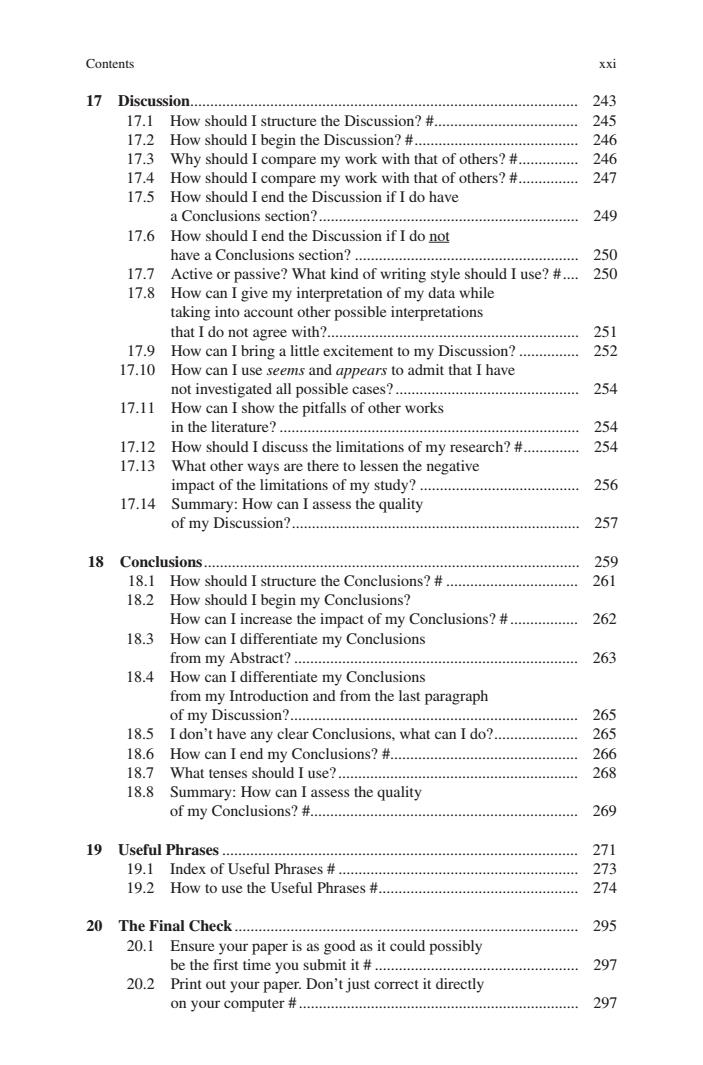
Contents xxi 17 Discussion.… 243 17.1 How should I structure the Discussion?#.................... 245 17.2 How should I begin the Discussion?#................... 246 17.3 Why should I compare my work with that of others?#........... 246 17.4 How should I compare my work with that of others?#.............. 247 17.5 How should I end the Discussion if I do have a Conclusions section?........ 249 17.6 How should I end the Discussion if I do not have a Conclusions section? 250 17.7 Active or passive?What kind of writing style should I use?#... 250 17.8 How can I give my interpretation of my data while taking into account other possible interpretations that I do not agree with?............. 251 17.9 How can I bring a little excitement to my Discussion?............... 252 17.10 How can I use seems and appears to admit that I have not investigated all possible cases?............. 254 17.11 How can I show the pitfalls of other works in the literature? 254 17.12 How should I discuss the limitations of my research?# 254 17.13 What other ways are there to lessen the negative impact of the limitations of my study?............ 256 17.14 Summary:How can I assess the quality of my Discussion?........ 257 18 Conclusions......... 259 18.1 How should I structure the Conclusions?#................. 261 18.2 How should I begin my Conclusions? How can I increase the impact of my Conclusions?#.............. 262 18.3 How can I differentiate my Conclusions from my Abstract?… 263 18.4 How can I differentiate my Conclusions from my Introduction and from the last paragraph 0 f my Discussi0n2… 265 18.5 I don't have any clear Conclusions,what can I do?................. 265 18.6 How can I end my Conclusions?# 266 18.7 What tenses should I use?. 268 18.8 Summary:How can I assess the quality of my Conclusions?#.… 269 19 Useful Phrases… 271 19.1 Index of Useful Phrases #.... 273 19.2 How to use the Useful Phrases #...... 274 20 The Final Check............ 295 20.1 Ensure your paper is as good as it could possibly be the first time you submit it #....................... 297 20.2 Print out your paper.Don't just correct it directly 0ny0rC0 mputer#… 297
Contents xxi 17 Discussion................................................................................................. 243 17.1 How should I structure the Discussion? #.................................... 245 17.2 How should I begin the Discussion? #......................................... 246 17.3 Why should I compare my work with that of others? #............... 246 17.4 How should I compare my work with that of others? #............... 247 17.5 How should I end the Discussion if I do have a Conclusions section?................................................................. 249 17.6 How should I end the Discussion if I do not have a Conclusions section? ........................................................ 250 17.7 Active or passive? What kind of writing style should I use? #.... 250 17.8 How can I give my interpretation of my data while taking into account other possible interpretations that I do not agree with?............................................................... 251 17.9 How can I bring a little excitement to my Discussion? ............... 252 17.10 How can I use seems and appears to admit that I have not investigated all possible cases? .............................................. 254 17.11 How can I show the pitfalls of other works in the literature? ........................................................................... 254 17.12 How should I discuss the limitations of my research? #.............. 254 17.13 What other ways are there to lessen the negative impact of the limitations of my study? ........................................ 256 17.14 Summary: How can I assess the quality of my Discussion?........................................................................ 257 18 Conclusions.............................................................................................. 259 18.1 How should I structure the Conclusions? # ................................. 261 18.2 How should I begin my Conclusions? How can I increase the impact of my Conclusions? # ................. 262 18.3 How can I differentiate my Conclusions from my Abstract? ....................................................................... 263 18.4 How can I differentiate my Conclusions from my Introduction and from the last paragraph of my Discussion?........................................................................ 265 18.5 I don’t have any clear Conclusions, what can I do?..................... 265 18.6 How can I end my Conclusions? #............................................... 266 18.7 What tenses should I use? ............................................................ 268 18.8 Summary: How can I assess the quality of my Conclusions? #................................................................... 269 19 Useful Phrases ......................................................................................... 271 19.1 Index of Useful Phrases # ............................................................ 273 19.2 How to use the Useful Phrases #.................................................. 274 20 The Final Check...................................................................................... 295 20.1 Ensure your paper is as good as it could possibly be the first time you submit it # ................................................... 297 20.2 Print out your paper. Don’t just correct it directly on your computer # ...................................................................... 297
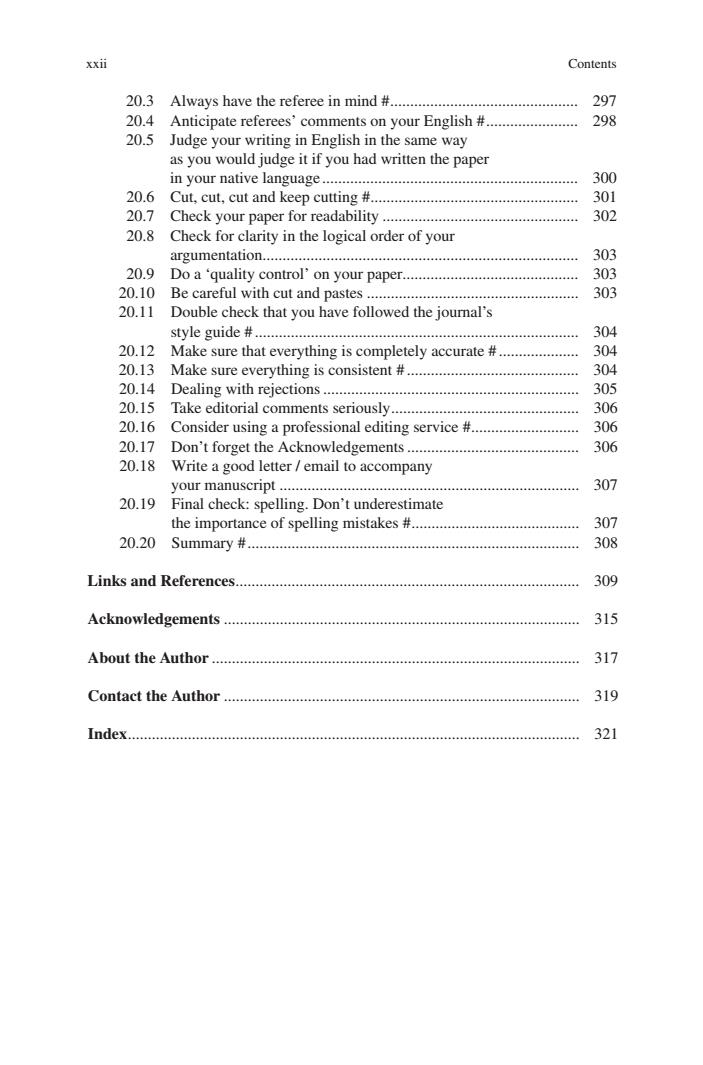
xxii Contents 20.3 Always have the referee in mind # 297 20.4 Anticipate referees'comments on your English #................... 298 20.5 Judge your writing in English in the same way as you would judge it if you had written the paper in your native language. 300 20.6 Cut,cut,cut and keep cutting# 301 20.7 Check your paper for readability... 302 20.8 Check for clarity in the logical order of your argumentation... 303 20.9Doa‘quality control'on your paper.… 44小44444444444444 303 20.10 Be careful with cut and pastes.. 303 20.11 Double check that you have followed the joural's style guide#… 304 20.12 Make sure that everything is completely accurate #............... 304 20.13 Make sure everything is consistent # 304 20.14 Dealing with rejections.................. 305 20.15 Take editorial comments seriously..... 306 20.16 Consider using a professional editing service #...................... 306 20.17 Don't forget the Acknowledgements.............. 306 20.18 Write a good letter/email to accompany your manuscript 307 20.19 Final check:spelling.Don't underestimate the importance of spelling mistakes #.... 307 20.20 Summary#.… 308 Links and References.................. 309 Acknowledgements… 315 About the Author............. 317 Contact the Author.. 319 Index....... 321
xxii Contents 20.3 Always have the referee in mind #............................................... 297 20.4 Anticipate referees’ comments on your English #....................... 298 20.5 Judge your writing in English in the same way as you would judge it if you had written the paper in your native language ................................................................ 300 20.6 Cut, cut, cut and keep cutting #.................................................... 301 20.7 Check your paper for readability ................................................. 302 20.8 Check for clarity in the logical order of your argumentation............................................................................... 303 20.9 Do a ‘quality control’ on your paper............................................ 303 20.10 Be careful with cut and pastes ..................................................... 303 20.11 Double check that you have followed the journal’s style guide # ................................................................................. 304 20.12 Make sure that everything is completely accurate # .................... 304 20.13 Make sure everything is consistent # ........................................... 304 20.14 Dealing with rejections................................................................ 305 20.15 Take editorial comments seriously............................................... 306 20.16 Consider using a professional editing service #........................... 306 20.17 Don’t forget the Acknowledgements........................................... 306 20.18 Write a good letter / email to accompany your manuscript ........................................................................... 307 20.19 Final check: spelling. Don’t underestimate the importance of spelling mistakes #.......................................... 307 20.20 Summary #................................................................................... 308 Links and References...................................................................................... 309 Acknowledgements ......................................................................................... 315 About the Author ............................................................................................ 317 Contact the Author ......................................................................................... 319 Index................................................................................................................. 321
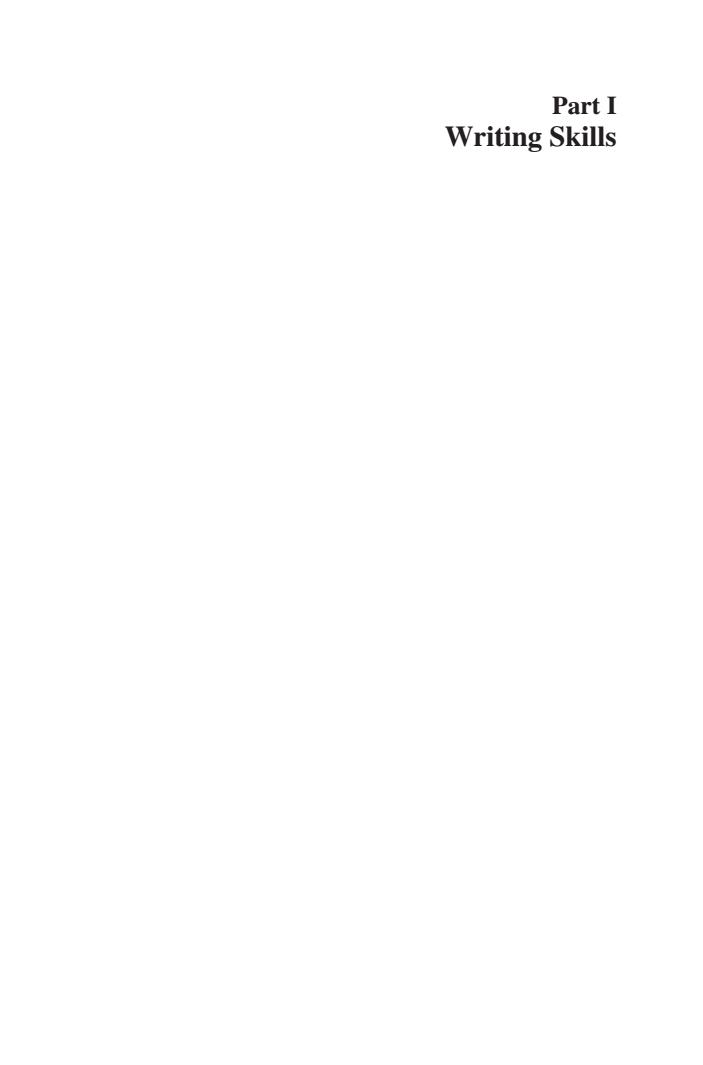
Part I Writing Skills
Part I Writing Skills
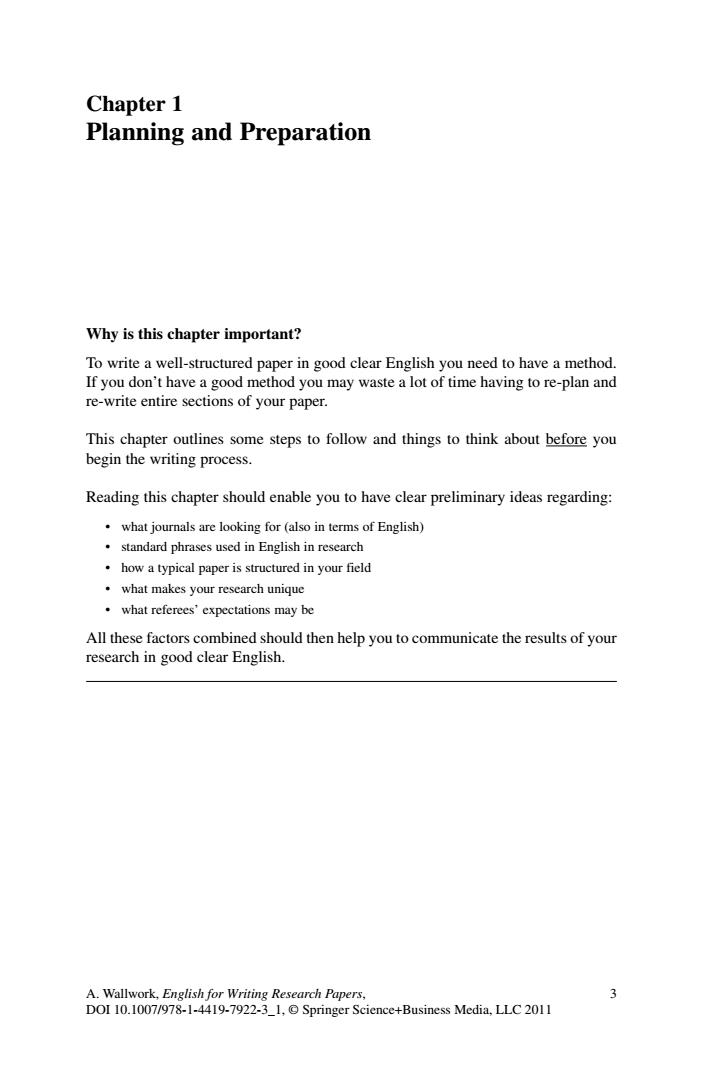
Chapter 1 Planning and Preparation Why is this chapter important? To write a well-structured paper in good clear English you need to have a method. If you don't have a good method you may waste a lot of time having to re-plan and re-write entire sections of your paper. This chapter outlines some steps to follow and things to think about before you begin the writing process. Reading this chapter should enable you to have clear preliminary ideas regarding: what journals are looking for (also in terms of English) standard phrases used in English in research how a typical paper is structured in your field what makes your research unique what referees'expectations may be All these factors combined should then help you to communicate the results of your research in good clear English. A.Wallwork.English for Writing Research Papers, 3 DOI 10.1007/978-1-4419-7922-3_1,Springer Science+Business Media,LLC 2011
A. Wallwork, English for Writing Research Papers, 3 DOI 10.1007/978-1-4419-7922-3_1, © Springer Science+Business Media, LLC 2011 Why is this chapter important? To write a well-structured paper in good clear English you need to have a method. If you don’t have a good method you may waste a lot of time having to re-plan and re-write entire sections of your paper. This chapter outlines some steps to follow and things to think about before you begin the writing process. Reading this chapter should enable you to have clear preliminary ideas regarding: • what journals are looking for (also in terms of English) • standard phrases used in English in research • how a typical paper is structured in your field • what makes your research unique • what referees’ expectations may be All these factors combined should then help you to communicate the results of your research in good clear English. Chapter 1 Planning and Preparation